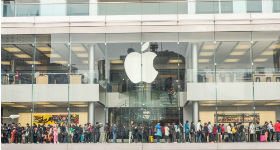Are we all sure now Apple makes a wearable? Ultra-rich Apple fan boys can now buy a gold Apple Watch at a starting price of $10,000 dollars while the less wealthy can start at $580 or for the mid-range stainless steel version – an expensive peripheral for an iPhone when an iPhone 6 lists starts at $649. Unfortunately, Apple's pricing and hype overshadowed three major technology feats announced the same day, one of which is actually incorporated into the watch.
The $10,000 list Apple Watch Edition uses a gold alloy that is twice as hard as "standard" 18 karat (18K) gold. And even 18K gold is an alloy of three parts gold to one part other stuff. Apple has a patented alloy that is a composite material, rather than a traditional mix of metals. The world is more familiar with composites such as carbon fiber golf clubs.
Apple's composite mixes in low-density ceramic particles to make its gold (alloy) harder and more scratch resistant. If I'm going to buy an Apple Watch Edition at over $17,000 once I put a band on it, I certainly don't want it to scratch. Skeptics say by using the low-density ceramic alloy, Apple uses less gold per volume when it makes watch casing, adding to some obscenely high-end margins on the device.
But you could apply the same technology to more mundane applications, such as regular stainless steel and, thereby making alloys that are harder and more scratch resistant. Phone, tablet, and laptop cases are all potential applications that would make devices thinner
 Image via Shutterstock
Image via Shutterstock
and lighter without sacrificing durability if put in a pocket or backpack. Apple has a fetish for making things thinner and lighter with every generation, so I'd expect more exotic metal formulations to show up in other products in the future.
Speaking of thinner and lighter, Apple's new MacBook – no more Air – comes in at a hair over 2 pounds in weight and a max height of roughly half an inch. The 12 inch full laptop represents the past and future in one design. Once again, Apple has refused to put a touch screen on its thinnest laptop, thereby ensuring another generation of fan boys will purchase a "real" laptop for work and an iPad for consuming content. This is an artificial design decision that is already in challenge by Microsoft's Surface Pro 3 and other Windows-based devices, be they tablets with keyboards or 2-in-1 devices that either fold the keyboard under for "tablet" usage or undock the keyboard and some weight to enable the use of the screen as a full function tablet.
USB-C is the future Apple embraced. While yet another generational connector change, it will ultimately bring the company further into line with the rest of the hardware world. Apple has incorporated a single USB-C port into the new MacBook, capable of providing charging, USB 3.1 generation one connectivity speeds up to 5 Gbps, and native DisplayPort 1.2 video output.
The USB-C port, like Apple's previous generation Lightning connector, also doesn't care which way the cable is plugged in, unlike previous generation USB ports that had to be aligned to snap in. It's a small thing, but Apple has harped upon the failings of earlier generation USB connectors having to be proper aligned before plugged in.
Where Apple blew it in its fetish for thinner-lighter bragging rights is sticking to a single USB-C port. You can charge or transfer data, but if you want to connect to an external monitor and get power at the same time, you are a port short. Connecting DisplayPort, HDMI, USB 2.0/3.0 and VGA monitors requires some very inelegant breakout boxes to split ports and plug things in, akin to the mess of boxes you have to buy to support the Apple iPad for external displays.
Apple argues you don't need all those ports because the wonders of wireless 802.11ac and Bluetooth 4.0 don't require you to carry as many wires, but I've yet to meet a conference room at an industry event without Ye Olde VGA required.
The other innovation Apple brought with the new MacBook is its trackpad. The trackpad doesn't "move" in the traditional sense, but uses Force Touch to detect how much pressure you apply to it. Rather than have to double-click, Apple provides the ability to "deep click" – press harder on the pad – in order to perform a function. The company brags it can tell between the press of a finger and a thumb, and the trackpad provides haptic touch feedback to your fingertips. I'm not a big haptic fan, since it tends to burn battery.
All three technologies introduced will no doubt show up in future Apple products as well as non-Apple products with a few tweaks.
Edited by
Maurice Nagle